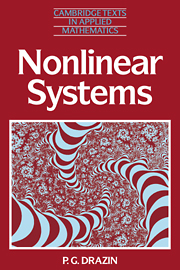Book contents
- Frontmatter
- Contents
- Preface
- 1 Introduction
- 2 Classification of bifurcations of equilibrium points
- 3 Difference equations
- 4 Some special topics
- 5 Ordinary differential equations
- 6 Second-order autonomous differential systems
- 7 Forced oscillations
- 8 Chaos
- Appendix A Some partial-differential problems
- Appendix B Additional problems
- Answers and hints to selected problems
- Bibliography and author index
- Motion picture and video index
- Subject index
- Plate section
1 - Introduction
Published online by Cambridge University Press: 05 June 2012
- Frontmatter
- Contents
- Preface
- 1 Introduction
- 2 Classification of bifurcations of equilibrium points
- 3 Difference equations
- 4 Some special topics
- 5 Ordinary differential equations
- 6 Second-order autonomous differential systems
- 7 Forced oscillations
- 8 Chaos
- Appendix A Some partial-differential problems
- Appendix B Additional problems
- Answers and hints to selected problems
- Bibliography and author index
- Motion picture and video index
- Subject index
- Plate section
Summary
Begin: to have commenced is half the deed. Half yet remains: begin again on this and you will finish all.
Ausonius (Epigrams no. xv)Nonlinear systems, bifurcations and symmetry breaking
A nonlinear system is a set of nonlinear equations, which may be algebraic, functional, ordinary differential, partial differential, integral or a combination of these. The system may depend on given parameters. Dynamical system is now used as a synonym of nonlinear system when the nonlinear equations represent evolution of a solution with time or some variable like time; the name dynamical system arose, by extension, after the name of the equations governing the motion of a system of particles, even though the nonlinear system may have no application to mechanics. We may also regard a nonlinear system as representing a feedback loop in which the output of an element is not proportional to its input. Nonlinear systems are used to describe a great variety of phenomena, in the social and life sciences as well as the physical sciences, earth sciences and engineering. The theory of nonlinear systems has applications to problems of economics, population growth, the propagation of genes, the physiology of nerves, the regulation of heart-beats, chemical reactions, phase transitions, elastic buckling, the onset of turbulence, celestial mechanics, electronic circuits and many other phenomena. This introduction to nonlinear systems, then, is an introduction to a great variety of mathematics and to diverse and numerous applications.
- Type
- Chapter
- Information
- Nonlinear Systems , pp. 1 - 47Publisher: Cambridge University PressPrint publication year: 1992



